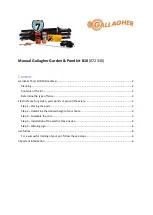
Section 3: Operating Instructions
RC(M)4715 & RCG(M)4715 Rotary Cutters 334-113M
6/3/20
37
Engage Blades
1. Select a gear range that will allow the cutter to make
a smooth cut without lugging the tractor down.
2. With wings lowered, increase throttle to a speed just
enough to get the cutter started without stalling
tractor, while slowly engaging power take-off. Use
tractor’s power take-off soft start option if available.
3. Ensure power shafts are rotating and cutter is not
vibrating excessively after ramping up to full power
take-off speed for at least 3 seconds. If excessive
vibration continues after 3 seconds at full power take-
off speed, disengage power take-off immediately,
shut tractor down, and remove switch key. Wait for
blades to stop rotating before dismounting tractor.
4. Investigate cause if cutter was shut down due to
excessive vibration.
See
on this page for detailed
instructions.
5. If cutter was not shut down, continue with forward
cutting operation at full power take-off operating
speed. Make a new gear selection if tractor is lugging
down or if cutter is making a rough cut.
6. Periodically, shut tractor down according to
on page 15 and
inspect cutter.
7.
Dismount tractor and check for objects wrapped
around blade spindles. Block deck up before
removing objects.
8. Frequently inspect cutter for loose bolts and nuts.
Tighten all loose hardware as indicated in the
“Torque Values Chart”
on page 65.
Disengage Blades
1. Slowly decrease throttle speed until engine idle
speed is reached.
2. Disengage power take-off.
3. Shut tractor down according to
IMPORTANT:
Cutter blades can lock-up against
each other during start-up and shut-down,
especially if tractor’s power take-off engagement is
“INSTANT ON” and/or “INSTANT OFF”. Follow Blade
Engagement and Blade Disengagement instructions
to help eliminate blade lock up.
IMPORTANT:
It will take longer for the blades to
come to a complete stop on cutters equipped with a
main driveline that has an overrunning clutch, as
opposed to a cutter with a main driveline that does
not have an overrunning clutch.
Blade Carrier Blockage Removal
During Field Use
DANGER
!
To avoid serious injury or death:
•
Do not walk, stand, or allow anyone else in the area where
a raised wing will fall unless the wing is securely locked in
the raised position with its transport lock.
•
Never place hands or feet under the deck or attempt to make
adjustments to the cutter with power take-off engaged.
Cutter blades rotating at high speeds cannot be seen and are
located close to the deck sides. Body extremities will be cut
•
Keep everyone away from the cutter when folding or
unfolding the wings or when raising or lowering the cutter.
The cutter can pinch or crush a person when performing
WARNING
!
To avoid serious injury or death:
•
Cutter blades can continue to rotate while decelerating
after power take-off is disengaged. Remain on the tractor
seat until rotating parts come to a complete stop.
•
Always follow “Tractor Shutdown Procedure” provided in
this manual before dismounting the tractor.
•
Do not attempt to remove blockages from blade carriers
while the wings are in the folded-up position. Blades can
become locked by blockages, creating the potential for
blades to swing freely in a harmful manner while removing
the blockages, bringing about the potential for serious
1. Ensure cutter is securely attached to tractor, then
park tractor and cutter on a level surface.
2. Disengage power take-off and wait for cutter blades
to come to a complete stop.
3. Raise cutter fully up with hydraulics.
4. Without relieving hydraulics, shut tractor down
5. Position all stroke control flip spacers to the fully
closed position, demonstrated in
6. Start tractor and lower cutter to rest on spacers.
7. Properly shut tractor down before dismounting. Make
sure to relieve all hydraulic pressure on lift and wing
cylinders.
8. While exercising caution, carefully proceed to cut
and remove any blockages.
9. Discard removed blockages appropriately so they do
not pose a hazard to the cutter once cutting resumes.
















































